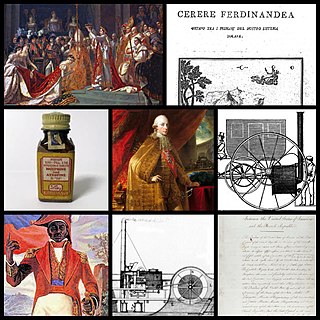
The 1800s was a decade of the Gregorian calendar that began on January 1, 1800, and ended on December 31, 1809. The term "eighteen-hundreds" can also mean the entire century from January 1, 1800 to December 31, 1899, and is almost synonymous with the 19th century (1801–1900). This article refers to the decade comprising 1800–1809.

William Murdoch was a Scottish engineer and inventor.

Richard Trevithick was a British inventor and mining engineer. The son of a mining captain, and born in the mining heartland of Cornwall, Trevithick was immersed in mining and engineering from an early age. He was an early pioneer of steam-powered road and rail transport, and his most significant contributions were the development of the first high-pressure steam engine and the first working railway steam locomotive. The world's first locomotive-hauled railway journey took place on 21 February 1804, when Trevithick's unnamed steam locomotive hauled a train along the tramway of the Penydarren Ironworks, in Merthyr Tydfil, Wales.

Camborne is a town in Cornwall, England. The population at the 2011 Census was 20,845. The northern edge of the parish includes a section of the South West Coast Path, Hell's Mouth and Deadman's Cove.
Steam power developed slowly over a period of several hundred years, progressing through expensive and fairly limited devices in the early 17th century, to useful pumps for mining in 1700, and then to Watt's improved steam engine designs in the late 18th century. It is these later designs, introduced just when the need for practical power was growing due to the Industrial Revolution, that truly made steam power commonplace.

Catch Me Who Can was the fourth and last steam railway locomotive created by the inventor and mining engineer Richard Trevithick. It was an evolution of three earlier locomotives which had been built for Coalbrookdale, Penydarren ironworks and Wylam colliery. Demonstration runs began in July 1808, and Catch Me Who Can was the first locomotive in the world to haul fare-paying passengers.

Sir Goldsworthy Gurney was an English surgeon, chemist, architect, builder, lecturer and consultant. He was a prototypical British gentleman scientist and inventor of the Victorian era.

Arthur Woolf was a Cornish engineer, most famous for inventing a high-pressure compound steam engine. As such he made an outstanding contribution to the development and perfection of the Cornish engine.

Dolcoath mine was a copper and tin mine in Camborne, Cornwall, England, United Kingdom. Its name derives from the Cornish for 'Old Ground', and it was also affectionately known as The Queen of Cornish Mines. The site is north-west of Carn Brea. Dolcoath Road runs between the A3047 road and Chapel Hill. The site is south of this road.

Francis Trevithick (1812–1877), from Camborne, Cornwall, was one of the first locomotive engineers of the London and North Western Railway (LNWR).

The London Steam Carriage was an early steam-powered road vehicle constructed by Richard Trevithick in 1803 and the world's first self-propelled passenger-carrying vehicle. Cugnot had built a steam vehicle thirty years previously, but that had been a slow-moving artillery tractor, not built to carry passengers.
Holman Brothers Ltd. was a mining equipment manufacturer founded in 1801 based in Camborne, Cornwall, England.

William Felton was a London coachmaker from 36 Leather Lane in Holborn, and 254 Oxford Street near Grosvenor Square, and noted for his 1796 illustrated two-volume "A Treatise on Carriages; comprehending Coaches, Chariots, Phaetons, Curricles, Gigs, Whiskies, &c Together with their Proper Harness in which the Fair Prices of Every Article are Accurately Stated." William Felton wrote in the book's introduction that he had no literary pretensions, but rather that his aim was to produce an authoritative guide to the construction, maintenance and repair of horse-drawn coaches. The Monthly Review agreed that it was not a literary masterpiece, but praised it for its encyclopaedic treatment of the subject. The Sporting Magazine in its sixth issue was equally complimentary about Felton's Treatise.

The Trevithick Society is a registered charity named for Richard Trevithick, a Cornish engineer who contributed to the use of high pressure steam engines for transportation and mining applications.
Francisco Uville was a Swiss entrepreneur who helped introduce steam engines into the mining industry of Peru. Through his efforts engines designed and built by the Cornish engineer Richard Trevithick were shipped to Peru and carried high over the Andes to the silver mines, where they were used to pump water and hoist ore. Uville went well beyond the mandate agreed with his partners in his arrangements to obtain the equipment. He died before seeing the enterprise collapse in 1820 during the Peruvian War of Independence.

Edward Bull (c.1759–1798) was an English engineer, noted for a modified type of steam engine known as the Bull engine. Working with Richard Trevithick, many of these were installed in mines in Cornwall.














